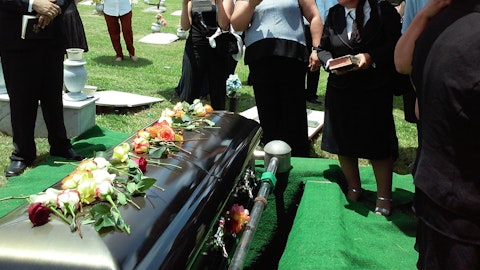Daniel Moore: Great. And last from me, and I will jump back €“ jump out. But just talk about free cash flow, I appreciate the updated guide. It sounds like on an adjusted basis, it would be up in the 90%s range in terms of conversion. You still expect to trend back towards closer to 100% over time, and you still expect to exit fiscal €˜23 with net leverage kind of in the low-2s, excluding additional M&A.
Bob VanHimbergen: Yes. So, simple answer is yes to both of those, Dan. As I mentioned in the past at the Investor Day, over a trend, we will be at that 100% free cash flow conversion. In the quarter, we did see, obviously, the MTS order pressure come through. And obviously, that turned into some lower cash advances. But over time, we still see 100% free cash flow conversion, and certainly cash flow picking up starting in Q2 here, not only from maybe orders coming back a bit, but also just our continued inventory levels continuing to be reduced over time as supply chain continues to improve. And on your leverage question, yes, we do anticipate being that low-2s range as we continue to pay-down debt. And so our 80%, 85% reflects certainly some of the impact from €“ reflects some of the cash advances, but also it reflects the costs associated with the Batesville transaction, that won’t qualify as discontinued operations.
Those are somewhat of a one-time cash impact that you will see in the year.
Daniel Moore: Very good. Thank you again for the color.
Kim Ryan: Thanks Dan.
Operator: Thank you. Your next question is coming from Matt Summerville from D.A. Davidson. Your line is now live.
Kim Ryan: Good morning Matt.
Will Jellison: Good morning. This is Will Jellison on for Matt Summerville this morning.
Kim Ryan: Good morning.
Bob VanHimbergen: Good morning.
Will Jellison: I wanted to start by asking you about price realization in the quarter with respect to both businesses, how that progress trended throughout the quarter and where you were with respect to price-cost spread?
Bob VanHimbergen: Yes. So, throughout fiscal €˜22, we continued to improve our processes around pricing and price-cost through our global supply chain management team, and that continued through the quarter. I think I have mentioned in the past, our backlog was protected. And as we saw that execute, we continue to be price-cost covered in the quarter. We are slightly favorable in dollars, but still dilutive of about 10 basis points on our EBITDA margins because of price-cost. And so I would expect that trend to continue throughout the rest of the year. We will be favorable in dollars, but obviously dilutive on a margin percentage.
Will Jellison: Understood. Okay. Thank you for that. And then as a follow-up, I would also like to learn a little bit more about the supply chain impact and how that progressed as we stand today, with respect to both your ability to ship and generate sales as well as the impact on free cash flow and your outlook there.
Bob VanHimbergen: Yes. I would say €“ I will provide just a couple of comments. I mean on the free cash flow, it certainly impacted our ability to execute some orders. And so as supply chain is constrained, what happens is we are not able to hit certain billing milestones and that’s primarily on the APS side. But that €“ we saw that coming into the year, and so I would say those supply chain challenges are reflected in our free cash flow outlook. But I would say on a part, I mean we do see supply chain improving in certain areas. However, there are certain engineered products. And I would say the two things that have the longest lead times still would be gearboxes and motors, and some of those are up to a 52-week lead time. And so we have been building inventory over the last probably a year and placing orders on those to get ahead of that.
Kim Ryan: And chips, I would say. So, those are a couple of areas where we have seen some delays and we haven’t really seen the improvement yet. I think it’s important to note that some of these systems that are engineered specifically on the APS side have very highly engineered components in them. There are only a few suppliers in the world that can meet the required specifications for those parts. And so the €“ working things through the supply chain when you are on a very limited supply base can take longer on items such as those.
Will Jellison: I appreciate you taking our question.
Kim Ryan: Great. Thank you.
Operator: Our next question is coming from John Franzreb from Sidoti & Company. Your line is now live.
John Franzreb: Good morning Kim and Bob. Thanks for taking the question.
Kim Ryan: Good morning.
John Franzreb: Just a little bit more color on the molding technology side of the business. It seems like the order intake was a little wider than you anticipated. Is that a function really of the geographic puts and takes that you kind of highlighted, or is there something else going on, on the customer level that we should be cognizant of?
Kim Ryan: No. I think typically, when we €“ when there are concerns around slowdown, you typically see that in some of the short to mid-term projects because they can be €“ decisions can be delayed or stopped and started and you don’t have significant amounts of time that you lose. On very large-scale projects, we very typically see everyone investing through the cycle. Because when you are working on a 2-year or 3-year or 4-year project, you can’t try and hit the peaks and valleys, you have to €“ you continuously invest. But mid-term projects, short-term projects can be delayed when people have concerns around cash preservation or just kind of waiting to see what happens in the economy. So, we have seen that last a little longer than we would have anticipated, and we are responding to that.
But the inquiries continue to be good. I wouldn’t say that it’s a geographic thing, save China. I think that the slowness we saw in China was absolutely isolated to some of the things going on around the zero COVID policy there in China, which is a large business for us in the MTS segment. But I would say, overall, I think this is just a general conservatism around making decisions and not wanting to start and stop projects, which obviously can drive up costs. So, rather delay the decision than start and stop something in the event that people need to slow down and preserve cash.
John Franzreb: And when that business turns around, does it turn around quickly, or is it a gradual recovery?
Kim Ryan: Yes. And these short-cycle businesses, generally, I would characterize all the industrial businesses. Short-cycle businesses are first and first out. And the longer as you go out in duration, they enter the cycle later and come out later.
John Franzreb: Got it. And just on the sales synergies, you highlighted Peerless and LINXIS. Could you talk a little bit about the opportunity profile as far as sales synergies? And what do you think is a reasonable benefit from bringing your businesses in with those?
Kim Ryan: So, yes, on the opportunity side, when €“ one of the things that we were really looking for was a place where we are going to be able to have kind of a one plus one equals three type of equation. And I think what LINXIS, what the LINXIS companies and Gabler and Herbold brought was extremely strong brands, great equipment providers. Periodically, they would sell those as subsystems, absolutely phenomenal customer relationships that have been built over long periods of time by €“ and great service that’s been delivered. But what we can add on the side from Coperion was a systems expertise and an ability to help augment their portfolio for things that they were previously buying out. And remember, the reason that the food market was particularly attractive or the recycling market is particularly attractive is because we have the capability to take our systems expertise, our highly engineered process knowledge and our products, which can be modified or reengineered to work in that market very effectively, bringing that together.
And that is really something that we think is kind of a secret sauce to penetrating this market with broader facing systems, less things that have to be bought out and an ability to cross-sell among the two. We also think that our ability to create back office synergies and more efficient procurements and global supply chain processes to help support that group can also help influence the margin profiles that we are looking for as well as our operating model around aftermarket.




